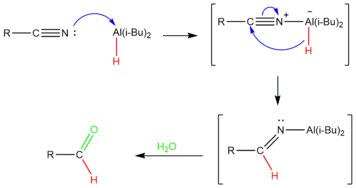In nitrile reduction a nitrile is reduced to either an amine or an aldehyde with a suitable chemical reagent.
Catalytic hydrogenation
The catalytic hydrogenation of nitriles is often the most economical route available for the production of primary amines. Catalysts for the reaction often include group 10 metals such as Raney nickel, palladium black, or platinum dioxide. However, other catalysts, such as cobalt boride, also can be regioselective for primary amine production:
- R-C≡N + 2 H2 → R-CH2NH2
A commercial application of this technology includes the production of hexamethylenediamine from adiponitrile, a precursor to Nylon 66.
Depending on reaction conditions, reactive intermediate imines can also undergo attack by amine products to afford secondary and tertiary amines:
- 2 R-C≡N + 4 H2 → (R-CH2)2NH + NH3
- 3 R-C≡N + 6 H2 → (R-CH2)3N + 2 NH3
Such reactions proceed via enamine intermediates. The most important reaction condition for selective primary amine production is catalyst choice. Other important factors include solvent choice, solution pH, steric effects, temperature, and the pressure of hydrogen.
Stoichiometric reductions
To amines
Reducing agents for the non-catalytic conversion to amines include lithium aluminium hydride, lithium borohydride, diborane, or elemental sodium in alcohol solvents.
To aldehydes
Nitriles can also be converted to aldehydes by reduction and hydrolysis. The Stephen aldehyde synthesis uses Tin(II) chloride and hydrochloric acid to yield an aldehyde via the hydrolysis of a resulting iminium salt. Aldehydes can also form using a hydrogen donor followed by in-situ hydrolysis of an imine. Useful reagents for this reaction include formic acid with a hydrogenation catalysis or metal hydrides, which are used to add one mol of hydrogen to the nitrile. For example, sodium borohydride reduces nitriles in alcoholic solvents with a CoCl2 catalyst or Raney nickel.
With diisobutylaluminium hydride

The hydride reagent Diisobutylaluminium hydride, or DIBAL-H, is commonly used to convert nitriles to the aldehyde. Regarding the proposed mechanism, DIBAL forms a Lewis acid-base adduct with the nitrile by formation of an N-Al bond. The hydride is then transferred to the carbon of the nitrile. Aqueous workup produce the desired aldehyde and ammonia.
Electrochemical methods
Benzyl nitriles can also be reduced electrochemically.
See also
References
- ^ Nishimura, Shigeo (2001). Handbook of Heterogeneous Catalytic Hydrogenation for Organic Synthesis (1st ed.). New York: Wiley-Interscience. pp. 254–277. ISBN 9780471396987.
- March, Jerry (1985). Advanced Organic Chemistry: Reactions, Mechanisms, and Structure (3rd ed.). New York: Wiley. ISBN 9780471854722. OCLC 642506595.
- Karsten, Eller; Henkes, Erhard; Rossbacher, Roland; Höke, Hartmut (2000). "Amines, Aliphatic". Ullmann's Encyclopedia of Industrial Chemistry. doi:10.1002/14356007.a02_001. ISBN 3527306730.
- Biggs, B. S.; Bishop, W. S. (1947). "Decamethylenediamine". Organic Syntheses. 29: 18. doi:10.15227/orgsyn.027.0018.
- Allen, C. F. H.; Wilson, C. V. (1947). "2,4-Diphenylpyrrole". Organic Syntheses. 27: 33. doi:10.15227/orgsyn.027.0033.
- Robinson, John C.; Snyder, H. R. (1943). "β-Phenylethylamine". Organic Syntheses. 23: 71. doi:10.15227/orgsyn.023.0071.
- Musser, Michael Tuttle (2000). "Adipic Acid". Ullmann's Encyclopedia of Industrial Chemistry. doi:10.1002/14356007.a01_269. ISBN 3527306730.
- Barrault, J. (1997). "Synthesis of fatty amines. Selectivity control in presence of multifunctional catalysts". Catalysis Today. 37 (2): 137–153. doi:10.1016/S0920-5861(97)00006-0.
- Ookawa, Atsuhiro; Soai, Kenso (1986). "Mixed solvents containing methanol as useful reaction media for unique chemoselective reductions within lithium borohydride". The Journal of Organic Chemistry. 51 (21): 4000–4005. doi:10.1021/jo00371a017.
- Hutchins, R. O.; Maryanoff, B. E. (1973). "2-tert-Butyl-1,3-diaminoproane". Organic Syntheses. 53: 21. doi:10.15227/orgsyn.053.0021.
- Suter, C. M.; Moffett, Eugene W. (1934). "The Reduction of Aliphatic Cyanides and Oximes with Sodium and n-Butyl Alcohol". Journal of the American Chemical Society. 56 (2): 487. doi:10.1021/ja01317a502.
- van Es, T.; Staskun, B. (1971). "4-Formylbenzenesulfonamide". Organic Syntheses. 51: 20. doi:10.15227/orgsyn.051.0020.
- Smith, Michael; March, Jerry (October 2001). March's advanced organic chemistry : reactions, mechanisms, and structure (5th ed.). New York: Wiley. ISBN 9780471585893. OCLC 43936853.
- Carey, F. A.; Sundberg, R. J.; Advanced Organic Chemistry, Part B: Reactions and Synthesis
- Solomons, T W. G, Craig B. Fryhle, and S A. Snyder. Organic Chemistry. , 2014. Print.
- V. Krishnan; A. Muthukumaran; H. V. K. Udupa (1979). "The electroreduction of benzyl cyanide on iron and cobalt cathodes". Journal of Applied Electrochemistry. 9 (5): 657–659. doi:10.1007/BF00610957. S2CID 96102382.
- V. Krishnan; A. Muthukumaran; H. V. K. Udupa (1983). Process for Electrochemical Preparation of beta phenylethylamine using cobalt black cathode (PDF). Calcutta: India Patent Office.